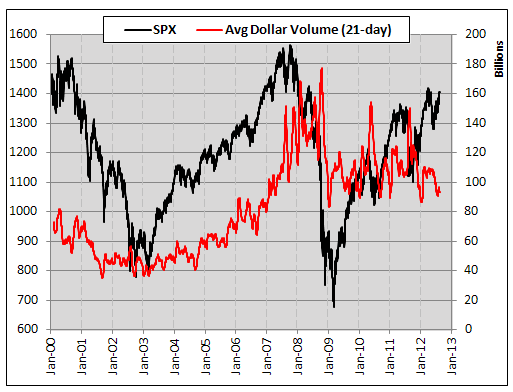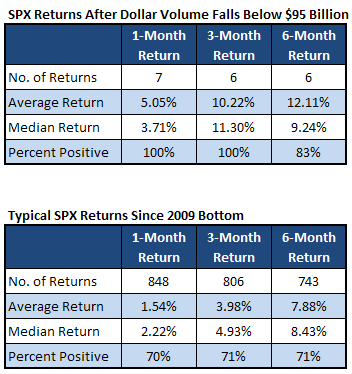A great explanation is set forth here in this great article by Ryan Detrick of Schaeffer’s Investment Research. Here he tells of some valid reasons for low absolute volume, of which there are good arguments. We just don’t see the big numbers as we used to see for various reasons. This is an excellent summary and with nice charts that tell the story.
Why Low Volume Is Actually Bullish
Schaeffer’s Senior Technical Strategist states his case against low-volume bears
One of the big knocks on this rally is that volume has been light. Tough to argue, because it has been. But what stands out about this argument is that it’s one we’ve heard from the bears since mid-2009. I remember doing various bull/bear debates back then, and the bounce on low volume was a common bullet point in the bears’ pocket. Fast-forward three years, and I’m hearing this exact same argument as a reason to be cautious.
My thinking has long been that volume in stocks is much lighter now than in the past because no one wants to own them anymore. We’ve lost a generation of traders over the years, so of course volume is lower. Also, there aren’t nearly as many hedge funds as there were just a few years ago, so again, less volume just makes sense. Then, considering some of the issues we’ve seen from the high-frequency trading (HFT) crowd — think Knight Capital Group Inc. (NYSE:KCG) here — and again, less volume is totally logical.
Lastly, to compare volume during the financial crisis versus now just seems wrong. We had a generational low in stocks (remember, volume always surges at lows, not tops) with various banking stocks (trading under $5) accounting for much of the volume. I forget the exact number, but there was a time that Citigroup Inc. (NYSE:C) made up a very large portion of overall trading volume. To compare volume over the past few years with what we saw during the financial crisis is apples to oranges.
Then, I came across what Michael Santoli of Barron’snoted regarding volume:
Yet in a report late last month, Brown Brothers Harriman strategists note that this is merely a partial give-back from the huge tripling of average volume from 2004 to 2009, as cheap high-speed trading and the financial crisis fed hyperactivity. More interestingly, they calculate that the unusual prevalence of very high-priced stocks today is helping to understate share volume. The number of stocks above $100 and the average price of shares in the S&P 500 are both near 22-year highs. Dollar volume, indeed, is up slightly from 2010.
This makes total sense. Whereas low-dollar bank stocks made up most of the volume, now the big, sexy names are the ones worth several hundred dollars. The Apple Inc.’s (NASDAQ:AAPL), Chipotle Mexican Grill, Inc.’s (NYSE:CMG), and Google Inc’s (NASDAQ:GOOG) of the world are the ones traders play now. Of course, your average trader can’t buy as much GOOG at $600, versus Bank of America Corp (NYSE:BAC) when it was $7. Then, let’s forget the fact that the S&P 500 Index (SPX) has doubled over the past three years. So, it’s safe to say most stocks have probably doubled as well. Again, how is lower volume a shock? It costs more to buy stocks, so people don’t buy as many.
Okay, enough of me just giving theories and reasons as to why we’ve continued to rally in the face of “weak” volume, let’s get to some quantified data. It always helps to back up any argument with some evidence. I worked closely with Rocky White in our Quantitative Analysis department on this, and here’s what we found. I was intrigued by the way Brown Brothers Harriman looked at volume, but also accounted for share price. So, we looked at all the stocks in the SPX and found their daily average dollar volume (stock price times stock volume). Then, to smooth things out, we made a 21-day moving average of the results.
Below is a chart of what we found. First things first, total-dollar volume is indeed less than during the peak of the financial crisis. However, it’s also still well above the bull market from 2003 to early 2007. So again, a very simple question comes to mind: If total-dollar volume is higher now than the last bull market, how in the world can bears say lower volume is bearish?

As a technician, I like to look at charts and see if anything jumps out at me. Well, my four-year-old daughter could probably tell you that the current total-dollar volume is down near its lowest levels since this recent bull market started. If you’ve at all paid attention to the market during the past month, then you know this isn’t a shock, as volume has really dried up overall. But again, is this bearish? We have a market that is breaking out to new monthly highs. So, is light volume a bearish sign?
We also did another study. As you can see by that chart above, when the total-dollar volume dipped beneath $95 billion or so, that is usually when it bounced. So, we checked out what the SPX did when total-dollar volume broke $95 billion, and wouldn’t you know, it’s bullish! Sure enough, low total-dollar volume is actually much more bullish looking at the at-any-time results since this broad-market rally started. See results below.

Lastly, it’s worth noting that total options and futures volume made a new high last year, and has been increasing every year for the past three years. Subsequently, you could also argue that the only investors left are more sophisticated and they are using options and futures, versus simply trading stocks.
In conclusion, does stock volume matter? A few years ago, I would have said absolutely. Now, after this study, I’m not so sure. Nonetheless, the results speak for themselves. And to me, as long as volume stays low and bears use it as ammunition for lower prices, just smile and nod your head, knowing this isn’t true.




















